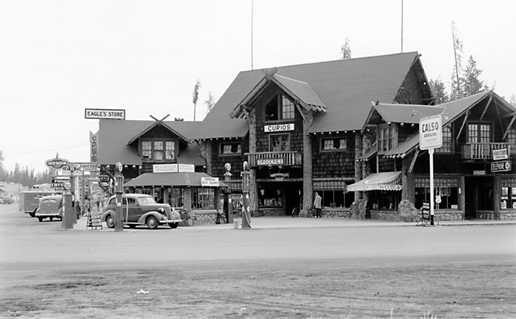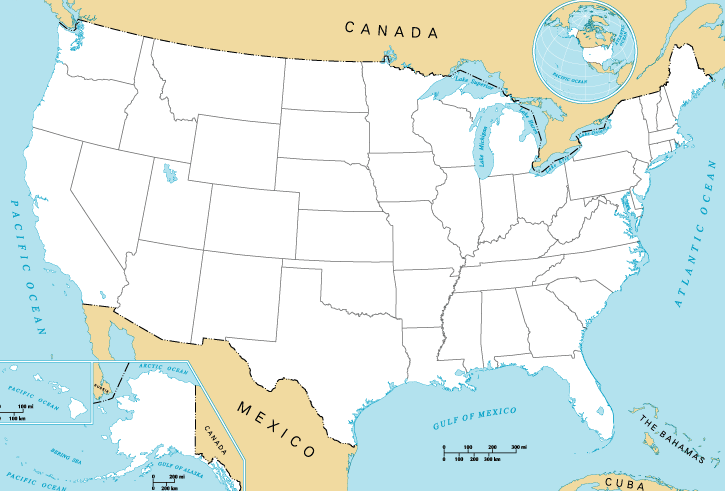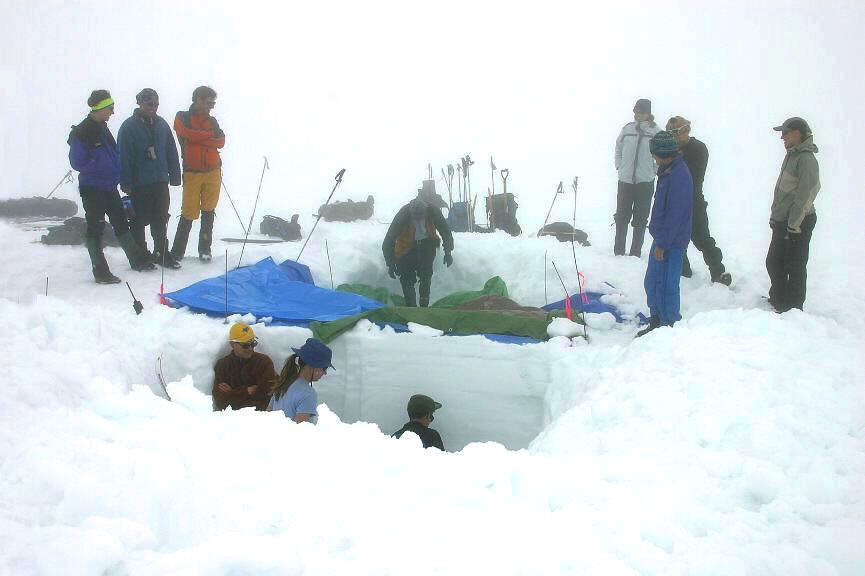|
West Yellowstone, Montana
West Yellowstone is a town in Gallatin County, Montana, United States, adjacent to Yellowstone National Park. The population was 1,272 at the 2020 census. West Yellowstone is served by Yellowstone Airport. It is part of the Bozeman, MT Micropolitan Statistical Area. West Yellowstone offers lodging, gift shops, and other services to travelers visiting nearby Yellowstone National Park. History Founded in June 1908 when the Oregon Short Line Railroad was completed, the town's name changed several times until West Yellowstone was settled upon in 1920. Train service to West Yellowstone ended in 1960. The town was incorporated in 1966. Geography According to the United States Census Bureau, the town has a total area of , all land. Climate At almost 7,000 feet above sea level and almost exactly halfway between the equator and the North Pole, West Yellowstone experiences a subarctic climate ( Köppen climate classification ''Dfc''), with cold — sometimes bitterly cold — wint ... [...More Info...] [...Related Items...] OR: [Wikipedia] [Google] [Baidu] |
Town
A town is a human settlement. Towns are generally larger than villages and smaller than city, cities, though the criteria to distinguish between them vary considerably in different parts of the world. Origin and use The word "town" shares an origin with the German language, German word , the Dutch language, Dutch word , and the Old Norse . The original Proto-Germanic language, Proto-Germanic word, *''tūnan'', is thought to be an early borrowing from Proto-Celtic language, Proto-Celtic *''dūnom'' (cf. Old Irish , Welsh language, Welsh ). The original sense of the word in both Germanic and Celtic was that of a fortress or an enclosure. Cognates of ''town'' in many modern Germanic languages designate a fence or a hedge. In English and Dutch, the meaning of the word took on the sense of the space which these fences enclosed, and through which a track must run. In England, a town was a small community that could not afford or was not allowed to build walls or other larger fort ... [...More Info...] [...Related Items...] OR: [Wikipedia] [Google] [Baidu] |
Yellowstone Airport
Yellowstone Airport is a state-owned public-use airport located adjacent to U.S. 191/U.S. 287 one nautical mile (2 km) north of the central business district of West Yellowstone, a town in Gallatin County, Montana, United States. Although only open from June through September, commercial passenger service is available during those months. Scheduled airline service is subsidized by the federal Essential Air Service (EAS) program. As per Federal Aviation Administration records, the airport had 4,186 passenger boardings (enplanements) in calendar year 2008, 4,331 enplanements in 2009, and 4,451 in 2010. It is included in the National Plan of Integrated Airport Systems for 2011–2015, which categorized it as a ''non-primary commercial service'' airport (between 2,500 and 10,000 enplanements per year). The town of West Yellowstone is located near the west entrance to Yellowstone National Park. The airport should not be confused with Yellowstone Regional Airport in Cody ... [...More Info...] [...Related Items...] OR: [Wikipedia] [Google] [Baidu] |
Population Density
Population density (in agriculture: Stock (other), standing stock or plant density) is a measurement of population per unit land area. It is mostly applied to humans, but sometimes to other living organisms too. It is a key geographical term.Matt RosenberPopulation Density Geography.about.com. March 2, 2011. Retrieved on December 10, 2011. In simple terms, population density refers to the number of people living in an area per square kilometre, or other unit of land area. Biological population densities Population density is population divided by total land area, sometimes including seas and oceans, as appropriate. Low densities may cause an extinction vortex and further reduce fertility. This is called the Allee effect after the scientist who identified it. Examples of the causes of reduced fertility in low population densities are * Increased problems with locating sexual mates * Increased inbreeding Human densities Population density is the number of people pe ... [...More Info...] [...Related Items...] OR: [Wikipedia] [Google] [Baidu] |
Census
A census is the procedure of systematically acquiring, recording and calculating information about the members of a given population. This term is used mostly in connection with national population and housing censuses; other common censuses include censuses of agriculture, traditional culture, business, supplies, and traffic censuses. The United Nations (UN) defines the essential features of population and housing censuses as "individual enumeration, universality within a defined territory, simultaneity and defined periodicity", and recommends that population censuses be taken at least every ten years. UN recommendations also cover census topics to be collected, official definitions, classifications and other useful information to co-ordinate international practices. The UN's Food and Agriculture Organization (FAO), in turn, defines the census of agriculture as "a statistical operation for collecting, processing and disseminating data on the structure of agriculture, coverin ... [...More Info...] [...Related Items...] OR: [Wikipedia] [Google] [Baidu] |
Western Regional Climate Center
The Western Regional Climate Center (WRCC) is a climate research center serving the Western United States. The WRCC is one of six regional centers administered by the National Oceanic and Atmospheric Administration and National Centers for Environmental Information, and partners with the Nevada-based Desert Research Institute. The WRCC was established in 1986 and is based in Reno, Nevada. See also *National Climatic Data Center The United States National Climatic Data Center (NCDC), previously known as the National Weather Records Center (NWRC), in Asheville, North Carolina, was the world's largest active archive of weather data. Starting as a tabulation unit in New Or ... References External links * {{US-geo-stub National Oceanic and Atmospheric Administration Reno, Nevada 1986 establishments in Nevada ... [...More Info...] [...Related Items...] OR: [Wikipedia] [Google] [Baidu] |
Rogers Pass (Montana)
Rogers Pass is a mountain pass that rises above sea level and is located on the Continental Divide in the U.S. state of Montana. The pass is adjacent to Helena National Forest and is traversed by Montana Highway 200, providing the shortest route between the cities of Great Falls and Missoula, Montana. Rogers Pass is more than south of Marias Pass, and there are no other roads that cross the Continental Divide between these two passes. The region between the two passes is mostly wilderness, and the majority of it has been set aside and protected from future development. The Great Bear, Scapegoat and Bob Marshall Wildernesses have been consolidated into the Bob Marshall Wilderness Complex and permanently protect . The region is noted for its inaccessibility and as one of the last strongholds for the grizzly bear in the lower 48 states. The Scapegoat Wilderness is a hike north of Rogers Pass via the Continental Divide Trail. Origin of name Rogers Pass in Montana was named ... [...More Info...] [...Related Items...] OR: [Wikipedia] [Google] [Baidu] |
Contiguous United States
The contiguous United States (officially the conterminous United States) consists of the 48 adjoining U.S. states and the Federal District of the United States of America. The term excludes the only two non-contiguous states, Alaska and Hawaii (also the last ones admitted to the Union), and all other offshore insular areas, such as American Samoa, Guam, the Northern Mariana Islands, Puerto Rico, and the U.S. Virgin Islands. The colloquial term "Lower48" is used also, especially in relation to just Alaska (Hawaii is farther south). The related but distinct term continental United States includes Alaska (which is also on the continent of North America but separated from the 48 states by British Columbia and Yukon of Canada), but excludes the Hawaiian Islands and all U.S. territories in the Caribbean and the Pacific. The greatest distance (on a great-circle route) entirely within the contiguous U.S. is 2,802 miles (4,509 km), between Florida and the State of Washington ... [...More Info...] [...Related Items...] OR: [Wikipedia] [Google] [Baidu] |
The Weather Channel
The Weather Channel (TWC) is an American pay television channel owned by Weather Group, LLC, a subsidiary of Allen Media Group. The channel's headquarters are in Atlanta, Georgia. Launched on May 2, 1982, the channel broadcasts weather forecasts and weather-related news and analysis, along with documentaries and entertainment programming related to weather. A sister network, Weatherscan, was a digital cable and satellite service that offered 24-hour automated local forecasts and radar imagery. Weatherscan was officially shut down on December 9, 2022. The Weather Channel also produces outsourced weathercasts, notably for CBS News and RFD-TV. The Weather Channel was a subsidiary of the Weather Company until the latter was bought by IBM in 2016. The Weather Channel licenses its weather data from IBM. History The Weather Channel was founded on July 18, 1980,USPTO filings: First Use (not First Use in Commerce date on various filings, including filing w/ serial number 7336982 ... [...More Info...] [...Related Items...] OR: [Wikipedia] [Google] [Baidu] |
Snowpack
Snowpack forms from layers of snow that accumulate in geographic regions and high elevations where the climate includes cold weather for extended periods during the year. Snowpacks are an important water resource that feed streams and rivers as they melt. Therefore, snowpacks are both the drinking water source for many communities and a potential source of flooding (in case of sudden melting). Snowpacks also contribute mass to glaciers in their accumulation zone. Assessing the formation and stability of snowpacks is important in the study and prediction of avalanches. Scientists study the physical properties of snow under different conditions and their evolution, and more specifically snow metamorphism, snow hydrology (that is, the contribution of snow melt to catchment hydrology), the evolution of snow cover with climate change and its effect on the ice–albedo feedback and hydrology, both on the ground and by using remote sensing. Snow is also studied in a more global contex ... [...More Info...] [...Related Items...] OR: [Wikipedia] [Google] [Baidu] |
Köppen Climate Classification
The Köppen climate classification is one of the most widely used climate classification systems. It was first published by German-Russian climatologist Wladimir Köppen (1846–1940) in 1884, with several later modifications by Köppen, notably in 1918 and 1936. Later, the climatologist Rudolf Geiger (1894–1981) introduced some changes to the classification system, which is thus sometimes called the Köppen–Geiger climate classification system. The Köppen climate classification divides climates into five main climate groups, with each group being divided based on seasonal precipitation and temperature patterns. The five main groups are ''A'' (tropical), ''B'' (arid), ''C'' (temperate), ''D'' (continental), and ''E'' (polar). Each group and subgroup is represented by a letter. All climates are assigned a main group (the first letter). All climates except for those in the ''E'' group are assigned a seasonal precipitation subgroup (the second letter). For example, ''Af'' i ... [...More Info...] [...Related Items...] OR: [Wikipedia] [Google] [Baidu] |
Subarctic Climate
The subarctic climate (also called subpolar climate, or boreal climate) is a climate with long, cold (often very cold) winters, and short, warm to cool summers. It is found on large landmasses, often away from the moderating effects of an ocean, generally at latitudes from 50° to 70°N, poleward of the humid continental climates. Subarctic or boreal climates are the source regions for the cold air that affects temperate latitudes to the south in winter. These climates represent Köppen climate classification ''Dfc'', ''Dwc'', ''Dsc'', ''Dfd'', ''Dwd'' and ''Dsd''. Description This type of climate offers some of the most extreme seasonal temperature variations found on the planet: in winter, temperatures can drop to below and in summer, the temperature may exceed . However, the summers are short; no more than three months of the year (but at least one month) must have a 24-hour average temperature of at least to fall into this category of climate, and the coldest month should a ... [...More Info...] [...Related Items...] OR: [Wikipedia] [Google] [Baidu] |
North Pole
The North Pole, also known as the Geographic North Pole or Terrestrial North Pole, is the point in the Northern Hemisphere where the Earth's rotation, Earth's axis of rotation meets its surface. It is called the True North Pole to distinguish from the Magnetic North Pole. The North Pole is by definition the northernmost point on the Earth, lying antipode (geography), antipodally to the South Pole. It defines geodetic latitude 90° North, as well as the direction of true north. At the North Pole all directions point south; all lines of longitude converge there, so its longitude can be defined as any degree value. No time zone has been assigned to the North Pole, so any time can be used as the local time. Along tight latitude circles, counterclockwise is east and clockwise is west. The North Pole is at the center of the Northern Hemisphere. The nearest land is usually said to be Kaffeklubben Island, off the northern coast of Greenland about away, though some perhaps semi-per ... [...More Info...] [...Related Items...] OR: [Wikipedia] [Google] [Baidu] |

.jpg)




